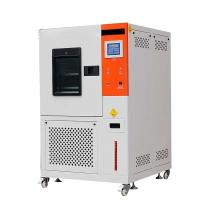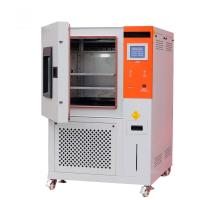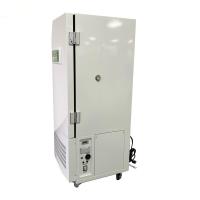In the highly competitive home appliance industry, ensuring the
durability, functionality, and safety of products is essential. The
Customized Environmental Test Chambers for Home Appliances play a
crucial role in simulating a wide range of real-world conditions
that these appliances will encounter during their lifespan. This
enables manufacturers to identify and address potential issues
before the products reach the hands of consumers.
These specialized test chambers are designed to evaluate the
performance of various home appliances, including refrigerators,
washing machines, air conditioners, microwave ovens, and
televisions. They serve appliance manufacturers, quality control
laboratories, and research institutions. The main objective is to
subject the appliances to different temperature, humidity, and
other environmental factors, as well as mechanical stresses, to
determine how they will function and hold up over time. By doing
so, manufacturers can optimize product designs, improve
manufacturing processes, and enhance the overall quality and
reliability of their home appliances.
- Sturdy and Spacious Design
- The chamber is constructed with a strong steel framework that
provides excellent stability and durability. The exterior is coated
with a corrosion-resistant finish to withstand the rigors of
testing and different environmental conditions. The interior is
large enough to accommodate a wide range of home appliances, from
compact countertop appliances to full-sized refrigerators and
washing machines. The walls are lined with a thermally conductive
and insulating material to ensure proper temperature control and
energy efficiency. The door is a heavy-duty component, featuring a
reliable sealing mechanism and a locking system to maintain a
consistent and controlled environment inside the chamber. A clear
viewing window, made of tempered glass, allows for easy monitoring
of the testing process without affecting the internal conditions.
- Precision Environmental Control Systems
- Temperature Control: Capable of maintaining a temperature range
from -30°C to +60°C, with an accuracy of ±1°C. It utilizes a
combination of compressor-based refrigeration and electric heating
elements. The control system is equipped with multiple temperature
sensors placed strategically throughout the chamber to ensure
uniform temperature distribution. The user-friendly control panel
allows for precise programming of temperature profiles, including
gradual temperature changes, constant temperature holds, and cyclic
temperature sequences, mimicking the temperature variations that
home appliances may experience, such as the cold environment in a
freezer, the warm air in a kitchen during cooking, or the
fluctuating temperatures in a storage room.
- Humidity Control: The humidity control system can achieve humidity
levels from 20% to 90% RH, with an accuracy of ±3% RH. It employs a
steam injection humidifier and a condenser dehumidifier, integrated
with a well-designed air circulation system. Humidity sensors
continuously monitor the internal humidity, and the control system
makes real-time adjustments to maintain the desired humidity
levels. This is important for testing the effects of moisture on
appliances, such as the rusting of metal parts in a humid
environment, the performance of electronic components in high
humidity, and the drying efficiency of a washing machine in
different humidity conditions.
- Dust and Particle Simulation: The chamber can also introduce
controlled amounts of dust and particles into the environment to
test the appliance's resistance to dirt and debris. This is
particularly relevant for appliances like air conditioners and
vacuum cleaners, as it helps determine how well their filters and
internal mechanisms can handle particulate matter. The dust
injection system is adjustable, allowing for different particle
sizes and concentrations to be used, simulating various real-world
dust and dirt scenarios.
- Mechanical Stress Testing Capabilities
- Vibration Testing: The chamber is equipped with a vibration table
that can generate vibrations with frequencies ranging from 5 Hz to
500 Hz and amplitudes adjustable from 0.5 mm to 20 mm. This is
useful for testing the durability of appliance components, such as
the motors and fans, under the mechanical stress of vibrations that
may occur during operation or transportation. The vibration system
can be programmed to simulate different vibration patterns,
including constant vibrations, intermittent vibrations, and
vibration spectra similar to those experienced in a moving vehicle
or on a vibrating floor.
- Door and Lid Cycling: For appliances with doors or lids, such as
refrigerators, washing machines, and microwave ovens, the chamber
can perform automatic door and lid cycling tests. It can open and
close the doors or lids at a specified frequency and with a
controlled force, simulating the normal usage patterns of
consumers. This helps evaluate the durability of hinges, latches,
and seals, ensuring that they can withstand repeated opening and
closing without premature wear or failure.
- Advanced Instrumentation and Data Acquisition
- The chamber is outfitted with a comprehensive suite of sensors and
instrumentation. In addition to temperature, humidity, vibration,
and door cycle sensors, it includes sensors for measuring power
consumption, water flow (for appliances like washing machines and
dishwashers), and air flow (for air conditioners and fans). These
sensors are connected to a state-of-the-art data acquisition system
that records and stores all relevant data. The data acquisition
system offers a sampling rate of up to 1000 samples per second,
ensuring that even the most rapid changes in environmental
conditions, appliance performance, or mechanical stresses are
accurately captured. The collected data can be accessed and
analyzed in real-time or retrieved later for in-depth studies. The
system is also compatible with common data analysis software,
enabling the generation of detailed reports and graphical
representations of the test results, which are essential for making
informed decisions about product improvements.
- Enhanced Safety and Compliance Features
- The Customized Environmental Test Chambers for Home Appliances are
designed with multiple safety features. It incorporates an
automatic shutdown system in case of any critical malfunction, such
as overheating, overcooling, excessive humidity, or a mechanical
failure. The chamber is equipped with a fire suppression system,
which can quickly extinguish any potential fires that may occur due
to electrical faults or appliance failures. The ventilation system
is designed to remove any harmful gases or fumes that may be
generated during testing, protecting both the appliances and the
operators. The control panel is designed with safety interlocks and
clear warning indicators to prevent accidental operation and ensure
the well-being of personnel. Additionally, the chamber complies
with relevant industry standards and regulations, such as IEC 60335
for household appliances safety and various national and
international quality and environmental testing standards, ensuring
that the testing procedures are recognized and accepted within the
home appliance industry.
- Chamber Size and Capacity: Available in different sizes to accommodate various appliance
sizes. The smallest models may have an internal volume of a few
cubic meters, suitable for testing small appliances like coffee
makers and toasters, while the largest chambers can have volumes
exceeding 20 cubic meters, capable of handling large refrigerators
and industrial-sized washing machines. The interior dimensions are
optimized for proper air circulation and uniform distribution of
environmental parameters. For example, a medium-sized chamber might
have interior dimensions of 3 meters x 3 meters x 2 meters,
providing enough space for testing a standard-sized refrigerator
and a washing machine simultaneously.
- Temperature Cycling Rate: The chamber can perform temperature cycles at a rate of 1 to 3
cycles per day, depending on the specific test requirements. For
example, it can cool from +25°C to -10°C in a few hours and then
warm back up, subjecting the appliances to significant thermal
stress. The ramp rate can be adjusted, typically ranging from 0.5°C
per minute to 5°C per minute, allowing for the simulation of
different thermal profiles.
- Humidity Cycling Rate: The humidity can be cycled within 30 minutes to 2 hours, enabling
the simulation of rapid changes in moisture conditions. For
instance, it can change the humidity level from 30% RH to 80% RH
and back, replicating the transitions that may occur when an
appliance is moved from a dry room to a humid bathroom or vice
versa.
- Vibration Frequency and Amplitude Range: The vibration system can generate frequencies from 10 Hz to 200
Hz, with amplitudes adjustable from 1 mm to 10 mm. These parameters
are suitable for testing the vibration resistance of most home
appliance components.
- Data Acquisition Rate: The data acquisition system samples sensor data at a rate of 500
samples per second, ensuring that even the slightest and most rapid
changes in temperature, humidity, vibration, or other parameters
during the test are accurately recorded and can be analyzed in
detail.
- Compliance with Industry Standards: Complies with IEC 60335 and other relevant industry standards,
ensuring that the testing is conducted in a manner consistent with
the requirements for home appliance safety and performance. This
compliance helps manufacturers prove the quality and reliability of
their products and facilitates market access and consumer
acceptance.
- Realistic Simulation of Home Appliance Usage Environments
- The primary function of this chamber is to provide a highly
accurate and realistic simulation of the environmental and
mechanical conditions that home appliances will face. By precisely
controlling temperature, humidity, vibration, and other factors, it
allows for the evaluation of how appliances will perform and
degrade over time. For example, it can determine if a
refrigerator's cooling efficiency is affected by high humidity or
if a washing machine's motor can withstand the vibrations during a
spin cycle. This information is invaluable for appliance
manufacturers to optimize their designs, select appropriate
materials, and improve the overall quality and durability of their
products.
- The ability to conduct repeatable tests with different
environmental and mechanical profiles, as mandated by industry
standards, is also a crucial function. This helps in comparing the
performance of various appliance models or manufacturing processes
and identifying the most suitable solution. For instance, a
manufacturer can test multiple prototypes of a new air conditioner
under the same set of temperature, humidity, and vibration cycling
conditions and analyze the results to select the best-performing
and most reliable design.
- Enhanced Home Appliance Product Quality and Innovation
- Through comprehensive testing in the Customized Environmental Test
Chambers, appliance product developers can identify and address
potential issues in their designs. If an appliance shows signs of
failure or degradation during the test, appropriate measures can be
taken, such as improving the insulation, enhancing the corrosion
protection, or adjusting the motor design. This leads to the
development of more reliable and durable home appliances, reducing
the risk of product recalls and enhancing customer satisfaction. In
the research and development field, it allows for the exploration
of new materials and technologies, providing valuable data on their
behavior under different environmental conditions. For example,
researchers can study the performance of new energy-efficient
refrigerants or the durability of advanced composite materials for
appliance housings.
- The chamber also serves as a powerful tool for quality control. By
subjecting products to standardized environmental and mechanical
tests, manufacturers can ensure that their products meet the
required quality and performance standards. This helps in building
a reputation for quality and reliability in the highly competitive
home appliance market.
- Compliance with Home Appliance Industry Standards and Regulations
- The compliance of the test chamber with relevant home appliance
industry standards is a key aspect of its functionality. The home
appliance industry is highly regulated, and products must meet
specific standards to be sold and used. By using this chamber to
conduct tests in accordance with standards like IEC 60335,
manufacturers can prove that their products are safe and reliable.
Regulatory bodies and consumers rely on accurate test results
obtained from such chambers to enforce safety and quality
regulations, ensuring the proper functioning of home appliances and
the safety of users.
- Stringent Manufacturing Process
- The Customized Environmental Test Chambers for Home Appliances are
manufactured under strict quality control procedures. Each
component, from the refrigeration unit to the sensors and control
panel, is carefully sourced and inspected for quality and
performance. The assembly process is carried out by trained
technicians in a clean and controlled environment. The chamber
undergoes a series of calibration and validation tests during the
manufacturing process to ensure that it meets the required accuracy
and performance standards.
- The calibration of the temperature, humidity, and other sensors is
a critical part of the manufacturing process. It is performed using
traceable reference standards that are calibrated to the highest
levels of accuracy, guaranteeing the reproducibility of the test
results. Rigorous quality audits and inspections are conducted at
various stages of production to maintain the highest level of
product quality and compliance with home appliance industry
standards.
- Quality Certification and Validation
Our chamber has obtained relevant quality certifications and has
been validated by independent home appliance testing laboratories.
It has been proven to provide accurate and reliable test results,
conforming to the relevant industry standards. We also continuously
update and improve our product based on the latest technological
advancements and customer feedback from the home appliance industry
to ensure its long-term performance and compliance.
- Refrigerator and Freezer Testing
- A major appliance manufacturer used the Customized Environmental
Test Chambers to test a new line of energy-efficient refrigerators.
The tests revealed that the compressor was overheating in
high-temperature and low-humidity conditions, leading to reduced
efficiency. By improving the compressor's cooling system and using
a more heat-resistant lubricant, they were able to enhance the
refrigerator's performance and energy efficiency, resulting in
significant cost savings for consumers and increased market
competitiveness.
- A freezer manufacturer tested their products in the chamber. The
testing identified a problem with the door seal's durability in
cold and humid conditions, causing frost buildup. By using a
different seal material and improving the sealing mechanism, they
were able to eliminate the frost issue and improve the freezer's
overall performance and food preservation capabilities.
- Washing Machine and Dryer Testing
- An appliance company tested their new washing machines in the
chamber. The tests showed that the drum bearings were wearing out
prematurely due to vibration and high humidity. By using a more
durable bearing material and improving the vibration isolation of
the drum, they were able to increase the washing machine's lifespan
and reduce maintenance requirements.
- A dryer manufacturer used the chamber to evaluate the performance
of their new condenser dryers. The testing helped them optimize the
condenser design and improve the drying efficiency in different
humidity levels, resulting in faster drying times and lower energy
consumption.
- Air Conditioner and Heater Testing
- An air conditioner manufacturer tested their products in the
chamber. The testing identified a weakness in the heat exchanger's
resistance to corrosion in humid and salty environments. By using a
corrosion-resistant coating and improving the drainage system, they
were able to enhance the air conditioner's durability and
performance in coastal areas.
- A heater manufacturer tested their electric heaters in the chamber.
The tests revealed that the thermostat was inaccurate in extreme
cold temperatures, leading to overheating or underheating. By
calibrating the thermostat and using a more temperature-stable
sensor, they were able to improve the heater's temperature control
and safety.
- Small Appliance Testing
- A coffee maker manufacturer tested their products in the chamber.
The testing helped them determine the optimal temperature and
humidity conditions for brewing coffee and identified potential
issues with the plastic components in high-temperature
environments. By using a heat-resistant plastic and adjusting the
brewing temperature profile, they were able to improve the coffee
maker's performance and quality.
- A toaster manufacturer tested their new models in the chamber. The
tests showed that the heating elements were prone to failure in
dusty environments. By improving the element's protection and
adding a dust filter, they were able to increase the toaster's
reliability and lifespan.


- Pre-Sales Technical Consultation
Our team of home appliance industry experts provides in-depth
technical consultations to help customers understand the
capabilities and suitability of the Customized Environmental Test
Chambers for their specific testing needs. We offer demonstrations
and training, tailored to the home appliance industry, to
familiarize customers with the operation and functionality of the
equipment before purchase. We also assist in selecting the
appropriate test methods and accessories based on the appliances to
be tested. - After-Sales Service and Maintenance
We offer comprehensive after-sales service, including on-site
installation and commissioning. Our technicians are available for
regular maintenance, calibration, and emergency repairs. We provide
spare parts and upgrades to keep the test chamber operating at peak
performance. We also offer service contracts that include
preventive maintenance and priority technical support, ensuring the
long-term reliability and availability of the equipment for home
appliance testing. - Training and Technical Support
We conduct training programs for new users to ensure they can
effectively operate the Customized Environmental Test Chambers and
interpret the test results. Our technical support team is available
24/7 to answer questions, provide troubleshooting assistance, and
offer guidance on test method optimization and compliance with home
appliance industry standards. We also provide software updates and
support for the data acquisition and analysis systems, enabling
customers to take full advantage of the latest features and
technologies in home appliance environmental testing.
The Customized Environmental Test Chambers for Home Appliances are
an essential asset for any organization involved in the
development, manufacturing, or quality control of home appliances.
If you are looking to enhance your testing capabilities, ensure
compliance with industry standards, or drive innovation in the home
appliance field, this is the ideal solution. Contact us today to
learn more and get a customized quotation. Let us help you unlock
the full potential of your home appliance product quality control
and environmental testing.












